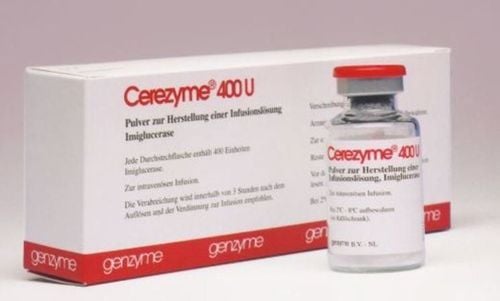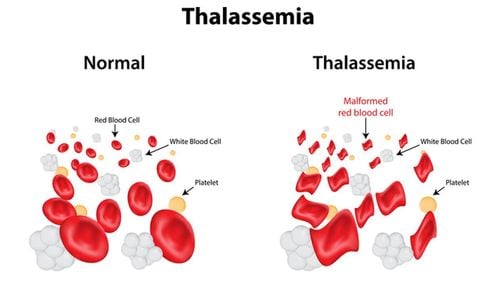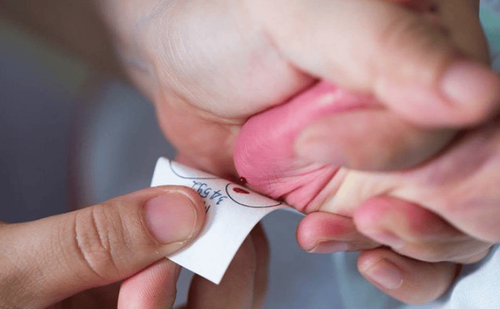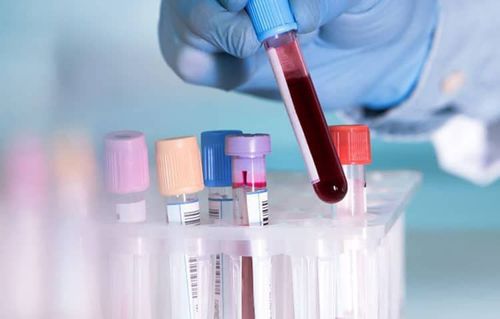This is an automatically translated article.
The article was professionally consulted by Dr. Nguyen Anh Tu - Radiologist - Department of Obstetrics and Gynecology - Vinmec Hai Phong International General Hospital.Thalassemia or hemolytic anemia is a disease that is passed from parents to children by recessive inheritance, the baby is born with the disease only if both parents carry the disease gene. There are now very simple tests for hemolytic anemia, which help determine the possibility of carrying the disease.
1. When to do antenatal hemolytic anemia test?
Thalassemia test is one of the necessary prenatal screening tests, especially for the following subjects:
There is a desire to screen for genetic diseases early in people who are about to get married. Women who are pregnant or planning to become pregnant. The husband of the pregnant woman has an abnormal blood test result. The spouse's family has a person who carries the gene or has Thalassemia. The couple has a child with Thalassemia.
2. What test for Thalassemia?
2.1.Blood blood Hemolysis is the first hemolytic anemia test that is preferred by doctors to diagnose anemia. Red blood cells contain hemoglobin, which carries oxygen to tissues and organs. Blood tests aim to evaluate important red blood cells and based on that to know if the body is anemic or not and if so, what type of anemia:| Các chỉ số | Giá trị bình thường |
|---|---|
| Hb: Hemoglobin |
13 - 18g/dL đối với nam 12 - 16g/dL đối với nữ |
| RBC: Số lượng hồng cầu | 4,2 - 5,4 triệu |
| MCV: Thể tích trung bình hồng cầu | 80-100 fl |
| Hct (Hematocrit): Tỷ lệ thể tích hồng cầu trên thể tích máu toàn phần |
45 - 52% đối với nam 37 - 48% đối với nữ |
| MCH (=Hb/RBC): Lượng hemoglobin trung bình trong một hồng cầu | 27 - 31 pg |
| MCHC (=Hb/Hct): Nồng độ hemoglobin trung bình trên một thể tích hồng cầu | 32 - 36 g/dL |
The above blood count test values may vary by laboratory. For adults, if the MCV index is < 80 fl, MCH < 27pg, it is likely a sign that the person has hypochromic anemia due to the Thalassemia gene or iron deficiency anemia. This method of testing for Thalassemia disease is being recommended by WHO because of its convenience, especially for people who are not specialized in hematology.
2.2. Serum Iron Serum iron is commonly used to measure related indices: Total Iron Binding Capacity (TIBC) and Ferritin. This test is often used to distinguish the cause of hypochromic anemia due to Thalassemia gene or iron deficiency. However, there are some cases where patients carrying Thalassemia gene are accompanied by iron deficiency, so with hypochromic anemia with iron deficiency, it is necessary to supplement iron and do blood tests again to avoid erroneous results. Serum iron results show that patients with hemolytic anemia when:
Iron in the blood increases Iron saturation can increase up to 80% Ferritin increased. 2.3. Hemoglobin electrophoresis Hemoglobin electrophoresis is one of the important types of hemolytic anemia tests, helping to determine the composition of hemoglobin types (oxygen transport subunits) present in the blood.
Normal and abnormal hemoglobin will have different molecular structures, resulting in them having different electrical charges and moving at different speeds under the action of an electric current. Therefore, hemoglobin electrophoresis will separate abnormal and normal hemoglobin by the action of electric current. From there, the doctor can see if there are abnormal hemoglobin in the patient's blood and even measure their levels.
Besides, too low or too high levels of normal hemoglobin types or the presence of abnormal hemoglobin in the blood are all signs of disease. Usually, abnormal types of hemoglobin are present, but do not cause many symptoms, or can lead to mild, transient conditions, but can sometimes cause life-threatening illness, for example such as thalassemia.

3. Steps to test Thalassemia gene carriers
Thalassemia is essentially a recessive inheritance, passed from parent to child, and the child only truly manifests the disease when both parents are carriers of the disease. Thus, people carrying the Thalassemia gene are completely capable of giving birth to healthy babies if they marry and have children with non-carriers.The test procedure for hemolytic anemia to detect Thalassemia gene carriers based on the genetic mechanism of the parents, is done step by step:
The first step is to order a complete blood cell analysis. review important laboratory indicators. Based on the results of the blood test, the doctor will order the second step of the test to measure the hemoglobin component in the blood. The doctor may then consider other tests to determine, for example, molecular biology testing to determine the risk of genetic mutations. In cases where both carriers of the disease get married and decide to have children, prenatal diagnostic methods (such as genetic diagnosis before embryo transfer or diagnosis on amniotic cells) show that It is still possible for parents to give birth to babies who do not carry the Thalassemia gene.
On the other hand, Thalassemia is a completely preventable disease. One of the important measures to prevent the disease, to gradually limit and stop the birth of sick children is to apply a long-term policy to manage and take special care of patients who already have the disease gene.

Currently, Vinmec International General Hospital is implementing a Pre-Marriage Examination Package, especially necessary for families who already have Thalassemia patients. The pre-marriage examination package at Vinmec helps parents screen for dangerous problems and perform Thalassemia test so that you can make the best decision for your future birth.
As a key area of Vinmec Health system, Pediatrics Department always brings satisfaction to customers and is highly appreciated by industry experts with:
Gathering a team of top doctors and nurses in Pediatrics : consists of leading experts with high professional qualifications (professors, associate professors, doctorates, masters), experienced, worked at major hospitals such as Bach Mai, 108.. Doctors All doctors are well-trained, professional, conscientious, knowledgeable about young psychology. In addition to domestic pediatric specialists, the Department of Pediatrics also has the participation of foreign experts (Japan, Singapore, Australia, USA) who are always pioneers in applying the latest and most effective treatment regimens. . Comprehensive services: In the field of Pediatrics, Vinmec provides a series of continuous medical examination and treatment services from Newborn to Pediatric and Vaccine,... according to international standards to help parents take care of their baby's health from birth to childhood. from birth to adulthood Specialized techniques: Vinmec has successfully deployed many specialized techniques to make the treatment of difficult diseases in Pediatrics more effective: neurosurgery - skull surgery, stem cell transplantation. blood in cancer treatment. Professional care: In addition to understanding children's psychology, Vinmec also pays special attention to the children's play space, helping them to have fun and get used to the hospital's environment, cooperate in treatment, improve the efficiency of medical treatment.
Please dial HOTLINE for more information or register for an appointment HERE. Download MyVinmec app to make appointments faster and to manage your bookings easily.














